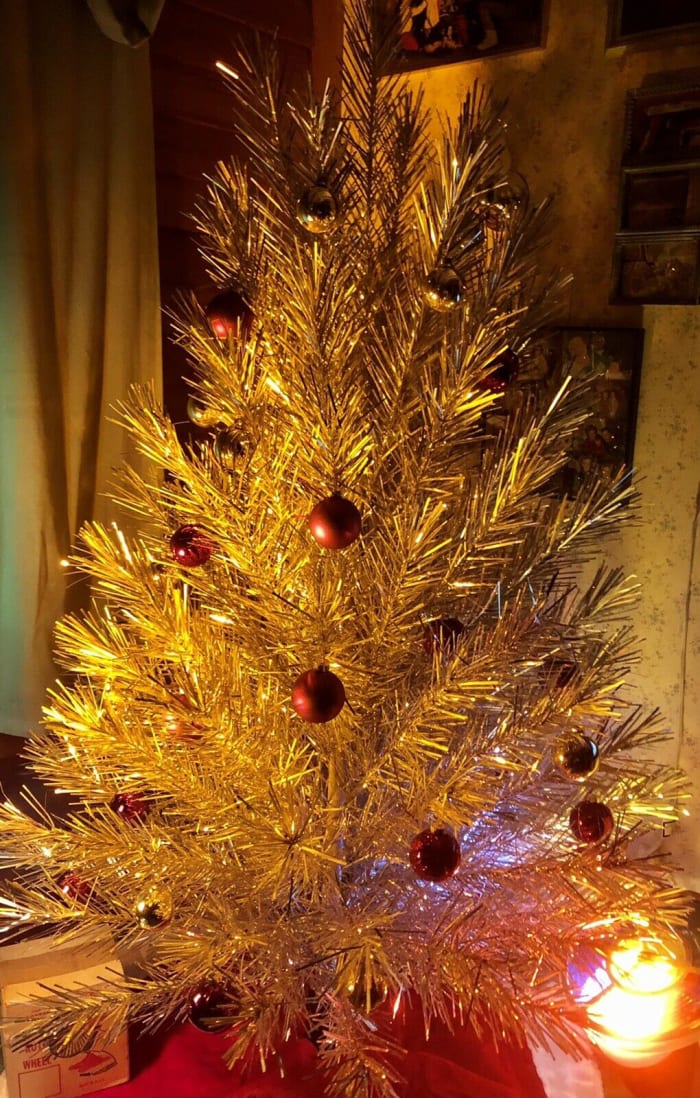There is a scene in the 1965 holiday classic, A Charlie Brown Christmas, when Charlie and Linus go shopping for the biggest aluminum Christmas tree Lucy asks them to get that’s “maybe painted pink.” They end up at a lot filled with aluminum trees in bright colors of violet, red, yellow, blue and the requested pink. There in the middle of those dazzling technicolor creations is the only real tree — a sad-looking little sapling that Charlie Brown zeroes in on.
Despite the reminder from Linus of the tree Lucy requested, and that the scrawny one “doesn’t seem to fit the modern spirit,” Charlie Brown says he doesn’t care and takes the tree with him anyway because “it needs me.” It was a happy ending for the little sapling, but eventually proved to be a sad one for the aluminum trees. The small, scraggly evergreen was seen as superior to the gaudy aluminum version: a triumph of the true and authentic over the fake and commercial.

A Charlie Brown Christmas production cel (Bill Melendez, 1965) of Charlie picking a scrawny real tree instead of a shiny aluminum one. Many point to this moment as the start of the decline in popularity of aluminum trees. This cel sold at auction for $21,510.
Image Courtesy Heritage Auctions
Many people point to the popularity of the special as being the reason for the decline in the popularity of aluminum Christmas trees, which were at their peak from 1958 to 1965. By 1967, two years after the special first aired, they were no longer being regularly manufactured. Maybe Charlie Brown did help push out aluminum trees or perhaps it was just a coincidence and they went the way of other fads by simply running their course.
Regardless, silver aluminum Christmas trees are an icon of space-age kitsch. A growing cadre of collectors, enthusiasts of mid-century modern design and those who appreciate the long lifespan and low maintenance of artificial trees view the sparkly metal totems as legitimate objets d’art and vintage trees now routinely sell for hundreds — rare ones for even thousands — of dollars. With many baby boomers fondly recalling the aluminum-gilded holidays of their youth, the metal trees also symbolize comforting nostalgia.

An Evergleam 94-branch stainless aluminum six-foot Christmas tree with tripod stand, 1960s, by Aluminum Specialty of Manitowoc, Wisconsin. The Shiny Brite ornaments shown on the tree were not included with the sale; $500.
Courtesy of rachelw3082 via eBay
The trend got its start in Manitowoc, Wisconsin, 61 years ago, where the now-defunct Aluminum Specialty Company made the first metal trees in 1959. According to the Wisconsin Historical Society, the story goes that in 1958, a toy sales manager saw a metal tree in a store window in Chicago and brought back the idea to the company. The original version he saw was a hard sell because it cost up to $150 at the time and was difficult to assemble.
Aluminum Specialty engineers were given the task of designing a tree that was affordable, portable and easy to assemble. They pulled it off in just three months and were ready to mass produce the trees, dubbed “Evergleams,” in time for the 1959 Christmas season. Cleverly designed, the trunks have pre-drilled holes to accommodate the metal branches, which feature woven aluminum “needles.” They lack that fresh pine aroma of real trees, but a pine-scented candle can create the missing olfactory experience.
At an affordable price point of $25, the trees were a huge success and became a design trend by the early 1960s. They ranged in height from two to eight feet. About 80 percent of all Evergleams were produced in silver, but with such a seasonal product, innovations in branch styles and colors were soon introduced to the expanding market, including yellow, pink and green. The trees appealed to the notion of modern living where life was clean, automated and easy; with an aluminum tree, needles never fell, it could be stored compactly and re-used every year, with none of the fuss of a real tree.
Aluminum Christmas trees were festive enough to stand alone, but homeowners often paired them with sets of brightly colored Shiny Brite ornaments and color wheels. Since stringing electric lights on a metal tree can cause a short circuit, manufacturers came up with the different lighting source of an illuminated color wheel. These wheels were usually positioned on the floor and aimed at the tree, and rotated to throw colored light onto the tree in blue, green, red and yellow, creating a cool reflective effect. The spectacle was sometimes further enhanced by a rotating tree stand. Stands and color wheels are standard accessories for today’s aluminum-tree fans.

The 94-branch vintage 6-foot Evergleam lit up in teal, with the aid of a color wheel.
Courtesy of myartschool via eBay
Aluminum Specialty produced more than 1 million of these trees. Their popularity increased rapidly for several years, with more than 40 other competitors, including Mirro, also located in Manitowoc, producing them.
Sales began to decline in the late 1960s when families joined the sentiments of Charlie Brown, who longed for a less commercial holiday. Final production of the Evergleam was in 1971, when the company re-focused its efforts on the children’s cookware sets for which it had always been known.
If you can’t find a vintage aluminum Christmas tree at your favorite antiques shop or flea market, there are many options online at Etsy.com and eBay.com. The cost of a full-size vintage aluminum tree can range anywhere from several hundred to several thousand dollars. Silver tends to be the least expensive, and pink the most pricey. When buying one, make sure it comes with paper sleeves to protect the branches during the rest of the year when it’s disassembled and packed up in storage.
The popularity of aluminum Christmas trees means that many quality reproductions are on the market, but if your heart is set on a vintage model, a smaller size can be more budget friendly. Trees under three feet can also be displayed on table tops or mounted on the wall as a nostalgic piece of holiday art.

A vintage pom-pom tree in a rare gold color, 6-1/2-feet high with 151 branches; $4,050.
Courtesy of newbuyer610 via eBay
Smaller vintage table-top aluminum trees, ranging from around 17 inches to four feet, are currently selling online between $30 to $300 — two-foot-tall Evergleam in the 1960s could be purchased for about $2. Taller trees from five to eight feet have been selling from $100 to $1,200. The price can be even higher for pom-pom trees, which flare at the end of each branch like a firework (non pompom models look more like a realistic branch), pom poms with colored “berries” in them, rotating trees and rare colored ones. On eBay, trees in those categories that recently sold include a gold pom-pom tree for $4,050; a gold Evergleam for $2,025; a green pom pom with red ornament tips for $1,250; a rare eight-foot tree with red and green pom poms for $1,400; and a six-foot revolving Evergleam tree with color wheel for $1,499. Color wheels are selling for $50 to $485.
Over the past few years, aluminum trees have made a comeback, and nowhere more so than in mid-century modern homes, where they just seem so at home. Many people also look at them as the “greener” option: While millions of real Christmas trees get thrown out every year, aluminum trees can be used over and over again.
Ultimately, though, perhaps the best reason to get one of these shimmering beauties is for the aesthetic: They’re the very definition of Yuletide cool.
You might also like:
The History of Shiny Brite Christmas Ornaments











